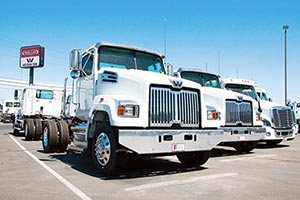Senior Reporter
July Class 8 Sales Tumble 39.8%

This story appears in the Aug. 22 print edition of Transport Topics.
U.S. retail sales of Class 8 trucks fell 39.8% in July from a year earlier, WardsAuto.com reported, as the trucking industry struggles with an uneven economy and the effects of earlier overproduction.
Sales dropped to 14,085, compared with 23,383 year-over-year. At the same time, Class 8 inventories are declining. Heavy-duty inventory in July slipped to 45,932 units from 52,512 a year earlier. The July level also was below the 46,911 units in June, according to Ward’s.
Ward’s also reported sales year-to-date decreased 19.3% to 118,243, compared with 146,571 in the 2015 period.
“Unfortunately, the industry — truckers first, then truck manufacturers — was just slow to react to the downturn in freight in 2015,” the peak year of the current cycle, said Steve Tam, vice president of the commercial sector for ACT Research Co.
“So it is going to take all of this year and a good portion of next year before we get back to that equilibrium,” Tam said.
“Major crosscurrents are at work that should be examined and evaluated within the context of each major truck manufacturer,” said Molly Zacker MacKay, vice president of operations at the research firm MacKay & Co. “Comparisons against July 2015 further distort our perception of the current situation.”
Freightliner remained the market share leader at 34.9% in July, but year-over-year sales fell 46.1% to 4,912 trucks. Western Star sold 385, a gain of 30, for a 2.7% share. Freightliner and Western Star are units of Daimler Trucks North America.
Jeff Sass, senior vice president of North America sales and marketing for Navistar Inc., described the current sales market as a “rough patch. … This is not a long road to a downturn.”
“Summer is historically slow anyway. … Don’t do year-end planning based on July,” said Mike Dozier, general manager of Kenworth Truck Co.
He said he expected industry sales to finish between 220,000 and 240,000 in 2016 and to be in the same range in 2017.
Kenworth and Peterbilt Motors Co. are brands of Paccar Inc.
“The relative strength of the construction sector remains a positive for Mack,” said John Walsh, Mack’s vice president of global marketing and brand management.
But reduced freight levels caused by “surplus inventories of goods across the economy and decreased manufacturing rates” were lowering on-highway sales, Walsh said.
Magnus Koeck, vice president of marketing at Volvo Trucks North America, said he still anticipates “a solid overall Class 8 market in 2016.”
Mack and VTNA are units of Volvo Group.
Mack sales fell 21.6% to 1,370, or a 9.7% share. VTNA’s sales dropped 41.2% to 1,562, or an 11.1% share.
Sales of International Trucks, a unit of Navistar International Corp., fell 56.7% to 1,276 and a 9.1% share.
Kenworth posted a 32.9% drop to 2,333, or a 16.6% share. Peterbilt sales declined 27.3% to 2,236, or a 15.9% share.
Despite the sales drop, suppliers and analysts remained somewhat upbeat.
“I think, at this point, we do still believe it is an inventory correction from the aggressive buy last year,” said Jeffrey Craig, CEO of supplier Meritor Inc.
“I think the manufacturing index has been positive the last two months,” Craig said during an earnings call on Aug. 3. “We’re seeing the outlook for ton-miles to be slowly increasing over time. What we look at is, over the long term, trucking moves almost exactly on a flat line with [gross domestic product] growth. So if the overall economy holds up, this [truck] inventory should clear the system, and we should go back to more normalized [sales] levels.”
Discussing the economy in a recent blog, Steve Graham, a partner at the research firm FTR, wrote, “Business inventories rose 0.2%, but sales rose 1.2% in June. Sales growth is allowing a cautious increase in inventory stocks, allowing production to take a baby step forward. The [business inventory-to-sales] ratio fell to 1.39, also a step in the right direction.”
The optimal range in the business inventory-to-sales ratio is 1.30 to 1.35 — or about what it was in late 2014, Bob Costello, chief economist at American Trucking Associations, said earlier this year at an industry meeting.

